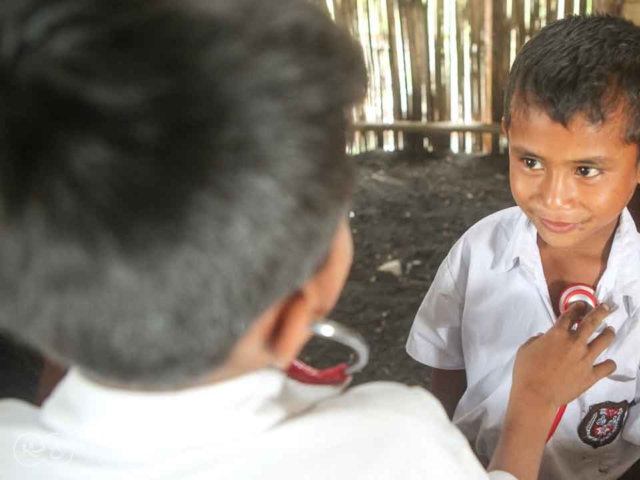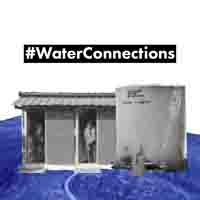In rural eastern Indonesia, families lack access to primary medical care. When a medical emergency occurs, everything becomes very complicated, and the risks are immense.
For an injured or sick person, getting any kind of medical treatment is a real challenge when you live far from everything, have no money, no means of transport and no road leading to the village.
As you all know, Fair Future is, above all, a medical foundation. From where we are now, communities and children do not have access to the most basic medical care.
Overall here, millions of people are forced to spend sometimes almost all of their income on medical expenses. Many of them will just wait for it to pass. This is the case here in the most rural regions, in which we work. The temporary application of first aid as initial medical care to a wound or injury until professional medical care is available can, in many cases, save lives.

Faced with this, and for nearly 15 years, we have been offering medical care to all who do not have access to it. But we are not always there when a medical problem arises, an accident requiring emergency medical care so that a wound does not become infected and becomes a more severe problem after a few hours. And after a few days, a real medical emergency, as we saw with Assa last January.
Hence the idea we had before the pandemic: Provide primary medical care to all children, with a first aid kit for each school/village located in the most rural areas of Sumba. The application of this program is training teachers in schools and rural communities by our medical teams within the framework of our base camp of Rumah Kambera.
What are we putting in place? Access to primary medical care in the event of an emergency in ultra-rural regions
Objective: How to transmit the gestures that can save a life?
What the foundation is putting in place is innovative and ingenious and cannot be done without the help of nearly fifty teachers from the poorest and rural areas of East Sumba. And yes, the teachers, like everywhere in the world, are the most influential people in the villages. They have heard that they are a source of knowledge and have the ability to learn and transmit knowledge to all.
Fair Future and Kawan Baik organize three to four-day training that invites teachers from these outermost regions to join our field medical teams, which include doctors, nurses and emergency care specialists. During these four days of training, they will learn how to treat a wound, give first aid to an injured or sick child so that his situation does not worsen and becomes much more severe. But also and above all, determine when it will be necessary to call a doctor or go to the nearest medical centre.
Save lives by treating a seemingly minor injury and preventing it from becoming serious.
Whether a minor skin wound or a severe life-threatening injury, all types of damage should be treated with first aid on the spot without delay, as it may save a life or a limb. First aid can help stop bleeding and prevent the spread of infections or venom. Applying first aid immediately can sometimes avoid expensive medical attention and help the wound heal with minimal scarring.
What are the most common types of injuries in the outermost regions? And how to react when damage occurs in an isolated village?
And above all, how to give first aid when most of the time the villagers have no direct access to water, no electricity, no telephone network, no road and no means of transport? Some concrete examples!
- Thermal injuries: Caused by extremely hot objects and surfaces that come into contact with the skin, such as boiling water, a hot stove, gasoline (like Assa), household fireplace;
- Eliminate the source of injury – Uncover or remove clothing from the burned area and wash with cool and clean (not cold) water – Alternatively, apply a cold compress until the pain subsides, then use a clean dressing with or without antibiotic cream.
- Penetrating wounds of the skin: These include punctures caused by stab wounds, bone fractures with open skin, wounds with axe or machetes, wounds related to vegetation because people walk barefoot;
- Clean the wound with clean water (if available) and apply firm, steady pressure if bleeding occurs – Cover the wound with a clean dressing and minimize movement as much as possible until the bleeding stops.
- Non-penetrating (blunt) skin wounds: These include concussions, lacerations (a tear-like skin wound), abrasions (the outer layer of skin is scraped and scratched)…
- For lacerations and abrasions, rinse the wound with clean water (if available), then clean it with a disinfectant solution such as diluted iodine – Apply topical antibiotic ointment and wrap the wound with a clean dressing – If a bone fracture is suspected, try not to move the patient’s fractured limb or wound site and contact Kawan Baik, Fair Future or Rumah Kambera for transport to a medical centre for treatment.
- Bites and stings: Such as those from humans, dogs, and snakes, or insects such as bees, spiders, or scorpions;
- Rinse the wound area with clean water (if available), and apply a disinfectant solution or topical antibiotic ointment – Cover the wound with a clean dressing and seek medical attention or contact Kawan Baik, Fair Future or Rumah Kambera – Learn how to take note the cause of the injury so that You can relay this information to the medical care team.
Are you a doctor, emergency doctor, or nurse? If you want to join this project with us, you are welcome, contact us here.
Rumah Kambera – East Sumba – September 5, 2022
Assaria is an excellent example of what could and should have been done if only one person had known what to do.
Assaria was eight years old when playing near the house’s fire in his village of Sumba East, a bottle of gasoline was set ablaze. These clothes ignited, causing excruciating 3rd-degree burns on approximately 25% of his body. Coming from a village where no road leads or almost no one owns a scooter, his family could not immediately bring him to the hospital but several days later. Assaria’s mother and father are farmers and do not know how to treat such wounds to reduce the very high risk of infection.
Assaria can barely walk today due to terrible burns to both legs and back and will have significant circulatory and neurological problems as he grows up. If nothing is done, he risks a double amputation. Assa must therefore undergo surgery to avoid much more severe health problems.
Where there is no doctor
The Foundation will create an illustrated book based on the book “Where there is no Doctor” by David Wegner. It will serve as a reference book and include all the information on prevention, patient care, first aid care, support for mothers and young women during pregnancy and much more.
In addition, the book will also cover knowledge about traditional medical treatments and the use of local natural resources. In the future, this book may be translated into the different dialects of Eastern Indonesia to serve as many people as possible.
Date of Photos: 2020-2022 | Location: East Sumba, NTT – Indonesia
In rural eastern Indonesia, families lack access to primary medical care. When a medical emergency occurs, everything becomes very complicated, and the risks are immense.
Getting any medical treatment is a real challenge for an injured or sick person when you live far from everything, have no money, no means of transport and no road leading to the village. We have been working on this program for years now with Fair Future.
What this gallery is about, Kawan?: Program for access to primary medical care for children. Learn to treat an injury before it is fatal. A program for each school/village in the most rural areas of Sumba. The inhabitants of rural villages do not have access to primary care, and most medical centres are often several hours away on foot. The harshness of life here means we often get hurt, but nothing is available to treat ourselves—no doctor, knowledge, medical equipment and, of course, no antiseptic or medicine. These injuries can lead to the death of a child or an adult if they get worse. We must therefore act quickly. Fair Future, for years, has empowered schools and families in ultra-rural communities to take action in the event of an accident. Today, we are taking another step in this program. – Thank you for your interest.




















